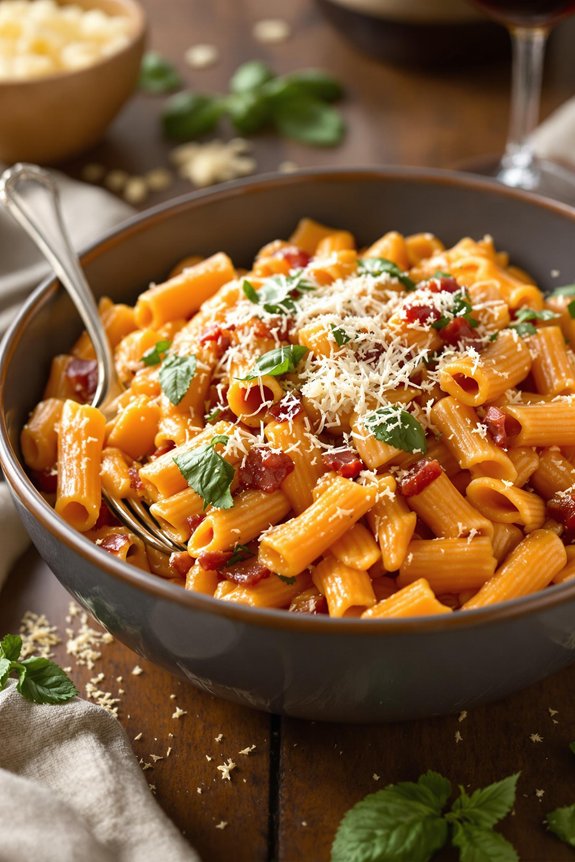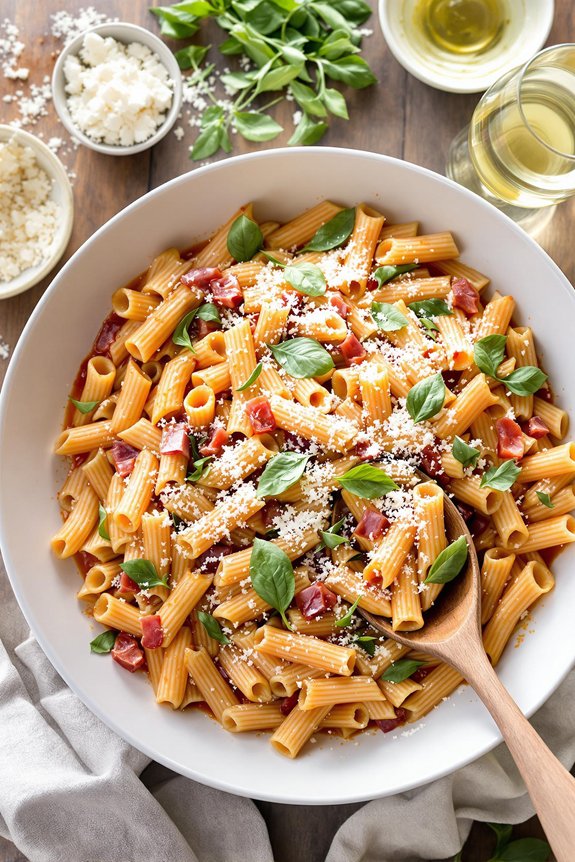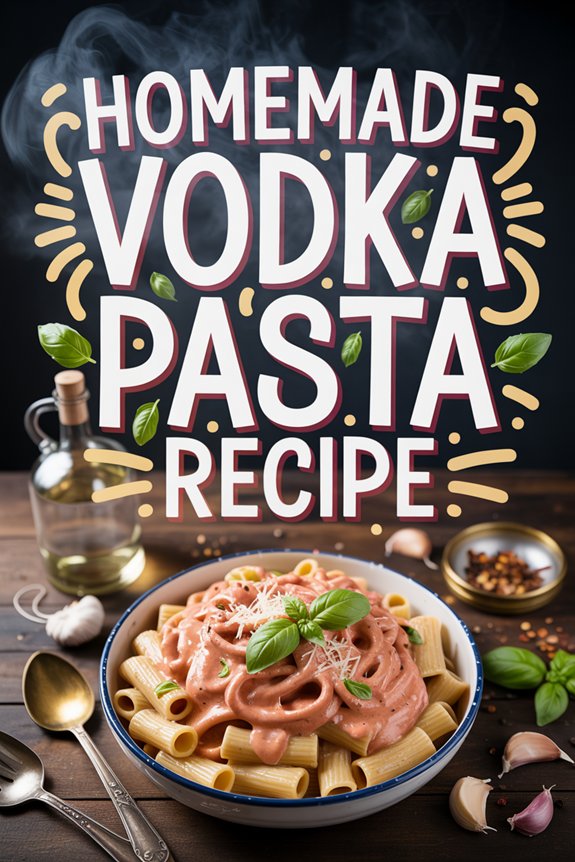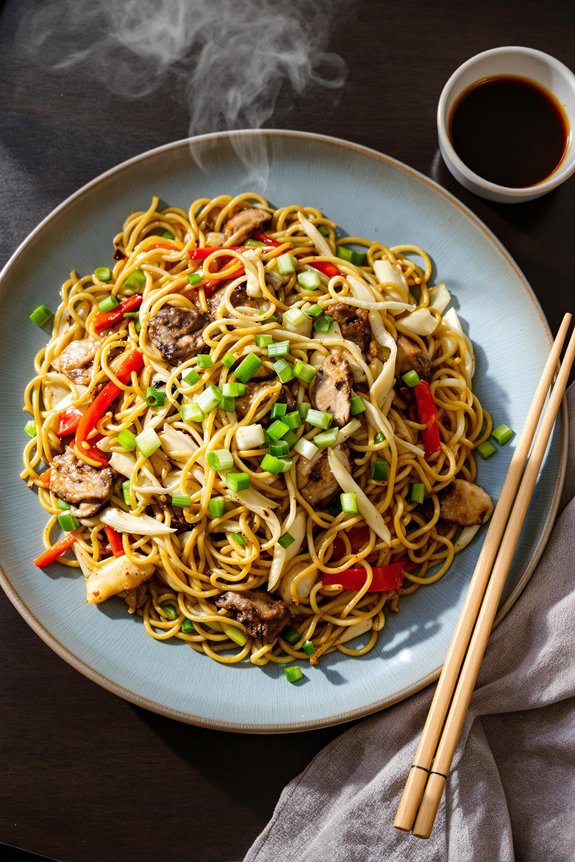Why You’ll Love this Vodka Pasta
Every single bite of this homemade vodka pasta delivers a perfect balance of flavors that’ll make your taste buds dance. The rich, velvety sauce combines creamy textures with the subtle kick of vodka and warmth of red pepper flakes—a combination that’s absolutely irresistible.
I’m particularly fond of how the prosciutto adds a savory depth while the garlic and butter create that aromatic foundation we all crave. Can you imagine anything more comforting?
The al dente rigatoni perfectly captures every drop of sauce in its ridges and hollow center. Trust me, this isn’t just dinner—it’s a mood-lifting experience that transforms ordinary weeknights into something special.
What Ingredients are in Vodka Pasta?
The heart of any great vodka pasta lies in its ingredients—a perfect blend of richness, acidity, and depth that creates that signature pink sauce we all crave. This recipe doesn’t skimp on flavor-building elements, from the aromatic garlic to the indulgent heavy cream.
What makes it truly special is how these relatively simple components transform when they come together, creating something that tastes much more complex than the sum of its parts.
- 1/4 cup butter
- 7 large garlic cloves, minced
- 1 cup vodka
- 1 (28 ounce) can crushed tomatoes
- 1/2 teaspoon red pepper flakes
- 2 tablespoons fresh basil, chopped
- Fresh black pepper, to taste
- 1/2 pound prosciutto, cut into small pieces
- 1 pint heavy cream
- 2 pounds rigatoni pasta, uncooked
- 1 cup Parmesan cheese, grated
When shopping for these ingredients, quality really does matter for a few key components. For the prosciutto, look for thinly sliced pieces from the deli counter rather than pre-packaged varieties.
The vodka doesn’t need to be top-shelf—any mid-range option works perfectly since the alcohol cooks off, leaving just the flavor enhancement.
And please, I beg you, use real Parmigiano-Reggiano rather than the pre-grated stuff in the green canister. The difference in the final dish? Night and day.
How to Make this Vodka Pasta

Making vodka pasta is one of those cooking experiences that feels fancy but isn’t actually complicated. Start by melting 1/4 cup butter in a large, deep skillet over medium heat, then add 7 large garlic cloves (minced) and let them dance and sizzle for 2-3 minutes until they turn golden and fragrant. This is where the magic begins—your kitchen will smell absolutely divine.
Be careful not to burn the garlic, which can happen in the blink of an eye and give your sauce a bitter taste.
Next comes the signature ingredient: 1 cup vodka. Pour it in and let it simmer for about 5 minutes, reducing the liquid by half. This step is essential because it cooks off the alcohol while leaving behind that subtle depth that makes vodka pasta so distinctive.
After the vodka has reduced, add the 28-ounce can of crushed tomatoes, 1/2 teaspoon of red pepper flakes for heat, and 2 tablespoons of freshly chopped basil. Season with freshly ground black pepper to taste. At this point, you could actually pause the recipe if you’re prepping ahead—the sauce base keeps beautifully until you’re ready for dinner.
About 30 minutes before you want to serve, bring the sauce back to a gentle simmer and stir in 1/2 pound of prosciutto cut into small pieces and a pint of heavy cream.
While the sauce melds together, cook 2 pounds of rigatoni pasta until it’s perfectly al dente—the pasta should have a slight bite to it. Drain the pasta, return it to the pot, and immediately toss with some of the grated Parmesan cheese (from the 1 cup you’ve set aside). This little step helps the cheese stick to the pasta before adding the sauce.
For those who love to experiment with pasta recipes, using a premium kitchen mixer can make the process more efficient, especially when preparing homemade pasta from scratch.
Finally, pour your gorgeous pink vodka sauce over the pasta, give it a good toss so every ridge of the rigatoni gets coated, and serve with the remaining Parmesan. The result? A restaurant-quality pasta that will have everyone thinking you spent hours in the kitchen.
Vodka Pasta Substitutions and Variations
While traditional vodka pasta follows a time-honored formula, you’re never stuck following the recipe exactly as written.
I’m all about making this dish your own. Don’t have prosciutto? Bacon or pancetta work beautifully, adding that same smoky depth.
Vegetarians can skip the meat entirely or add sautéed mushrooms for umami.
Cream too heavy? Try half-and-half or even whole milk for a lighter sauce.
The vodka can be replaced with white wine in a pinch, though you’ll miss that distinctive bite.
And the pasta shape? Penne, fusilli, or even fettuccine can step in for rigatoni.
What to Serve with Vodka Pasta
Since vodka pasta delivers such rich, creamy flavors with that signature tomato-vodka kick, you’ll want side dishes that complement rather than compete with your main attraction.
I recommend a simple arugula salad with lemon vinaigrette—the peppery greens and bright acidity cut through the creaminess perfectly.
Garlic bread is another no-brainer, ideal for sopping up that luscious sauce.
Need a veggie option? Roasted asparagus or broccolini, lightly seasoned with salt and olive oil, provides a welcome textural contrast.
For wine pairings, I’d go with a crisp Pinot Grigio or light Chianti—something that won’t overwhelm the pasta’s delicate flavor balance.
Final Thoughts
This homemade vodka pasta has completely changed my weeknight dinner game. There’s something magical about the combination of creamy sauce, prosciutto, and that hint of vodka that elevates a simple pasta dish to restaurant-worthy status.
I love how versatile it is, too. Don’t have prosciutto? Swap in bacon or pancetta. Need to make it vegetarian? Just omit the meat entirely.
The leftovers, if you’re lucky enough to have any, taste even better the next day as the flavors continue to develop. Trust me, this recipe deserves a permanent spot in your dinner rotation, and your family will thank you.





